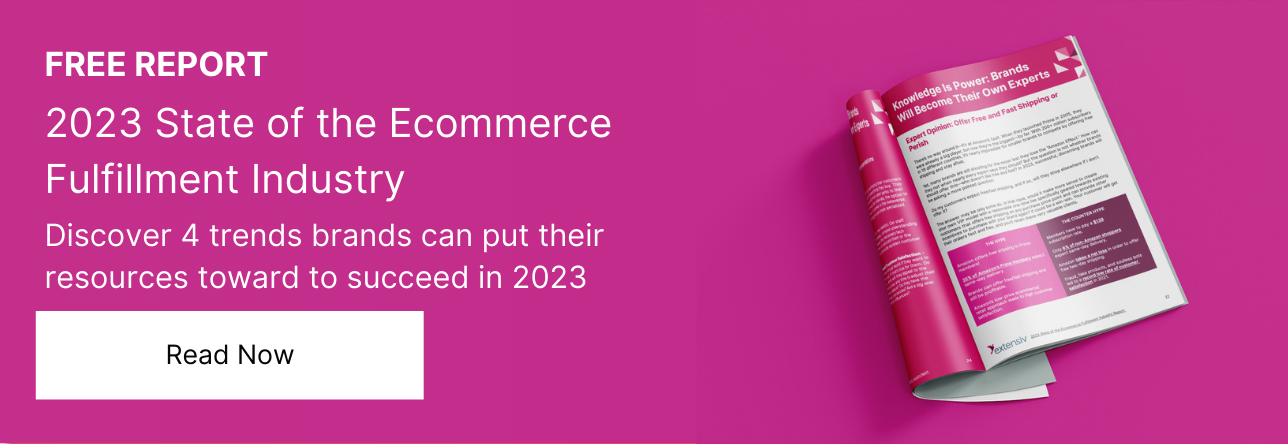It’s no secret that managing large quantities of inventory can present a challenge for ecommerce merchants. Online retailers have to juggle variability in demand, delays within the global supply chain, and other uncertain (or unreliable) forces that are sure to impact inventory levels. The tradeoff is, there are tons of action steps to offset these concerns, and to help maintain your inventory with efficiency and ease. With the right inventory optimization tools and techniques, your company can get a much clearer picture of its stock counts, mitigate any potential risks, and reduce its expenses while still keeping up with fluctuating order volumes.
What is inventory optimization?
Inventory optimization is a process for determining the appropriate stock levels to meet customer demand and provide quality service, but at the lowest cost to your company. A solid strategy for inventory optimization will keep logistics costs to a minimum, as well as help you bypass inventory issues like stockout and overstock events. Optimizing inventory is considered a best practice among the majority of ecommerce business owners, as it ensures effective stock control via real-time inventory tracking and accurate demand forecasting.
The business advantage of inventory optimization

Increase efficiency
Even veteran sellers and high-performing newcomers have room to improve operational efficiency or enhance their workflows to some degree. And that’s exactly where multi-echelon inventory optimization (MEIO) comes in, allowing retailers to track SKU performance across their entire distributor network. This caliber of inventory tracking helps strengthen allocation, so there’s always enough inventory at the most in-demand warehouse locations. That way, a larger volume of orders can be shipped out in a shorter period of time (and at a lower cost, as well).
Reduce cost
Reducing inventory costs is a priority for small businesses and large enterprises alike. But did you know the costs to warehouse your inventory are directly related to how well you optimize your stock? Optimization identifies stagnant inventory versus top selling SKUs, as well as which warehouses are best suited for specific order fulfillment. With this knowledge at your disposal, you can easily reduce your overhead and/or working capital (by getting rid of superfluous safety stock), and then invest that money back into the procurement of new products.
Delight customers
Most product-based businesses want to deliver superior customer service levels, in hopes of increasing both conversion and retention (i.e. brand loyalty). Inventory optimization is one of the best methods for delighting your customer base, because you can better guarantee orders are fulfilled quickly and correctly every time. Plus, preserving optimal inventory is a surefire way to avoid stockouts and backordered items, which means customers can always count on you to have the products they need (so they won’t wind up giving their business to a competitor).
How to optimize your inventory?

Have a reliable source of truth for inventory levels
Let’s face it: the thought of an impending inventory audit can bring about a lot of trepidation. Nevertheless, audits remain a reliable source of truth for your inventory levels — and having a good understanding of these metrics is integral to the health (and wealth) of your brand. Whether you conduct an audit manually or with the help of a proficient SKU inventory management system, gaining this kind of visibility into your SKUs will certainly optimize the way you operate.
Assess existing supply chain processes for inefficiencies
Any type of operational inefficiency, no matter how great or seemingly small, can prevent your business from reaching its full potential. That’s why it’s so necessary to assess your ongoing supply chain management, to pinpoint any areas that have room for improvement. Only when you have a deep understanding and awareness around what’s not working, can you begin to make moves toward optimizing your inventory strategy or inventory planning efforts.
Implement demand forecasting
When you implement consistent, precise inventory forecasting, you have the ability to make more informed decisions for your business. As you forecast demand, you’ll need to rely on historical sales and order data, since this information provides important insights into product trends and buyer behaviors. Then, with this data in tow, you can alleviate bottlenecks in the supply chain, optimize current (and future) inventory, and deliver on customer satisfaction.
Automate inventory management
By automating repetitive processes or time-consuming tasks, your entire approach to inventory management becomes accessible and efficient. That’s because automations enable you to reduce human error, minimize costs, and cut down on the hours spent dealing with inventory. When your company adopts innovative inventory management software, it can utilize these automations to optimize pricing and profitability, activate inventory reorder alerts, and more.
For example, consider the Orderbots from Extensiv. This automated technology is powered by real-time, multichannel data, so you can make use of ‘if-this-then-that’ logic to enhance order workflows and complete endless fulfillment tasks. With the incredible functionality and machine learning of Extensiv’s Orderbots, retailers can enjoy unmatched convenience and accuracy.
Leverage warehouse technology
A warehouse management system (WMS) helps to support and streamline warehouse logistics and distribution center management. By leveraging this cutting-edge software, your brand can reap tremendous visibility into its inventory levels and simplify supply chain planning in a snap. What’s more, a trusted WMS will help you maximize hours in the workday and your allotted warehouse space, by coordinating lead times, resource usage, and material flows.
Improve distribution logistics
Improving your distribution logistics goes hand in hand with optimizing inventory. If you can strategically store SKUs close to where the demand is — in other words, across multiple fulfillment centers — you’ll have an easier time fulfilling orders in a quick and cost effective manner. Distributed inventory is great for reducing holding costs, since you can ship products and tackle replenishment faster (which also maintains the quality of the customer journey).
Track progress
What’s the use in updating your processes if you don’t have a way to track your progress? Real-time inventory tracking and automatic updates are the keys to monitoring your company’s progress and managing your products across a vast distribution network. Utilizing tracking tools and advanced analytics helps merchants avoid excess inventory, overselling, or running out of an item too soon. And this way, you can have a firm grasp on your product catalog at all times.
How these brands optimized inventory
Tushy’s 10x journey

Due to the nationwide toilet paper shortage in spring 2020, Tushy experienced an incredible surge in their bidet sales — but luckily, they had Extensiv (formerly Skubana) to help navigate this massive influx. Thanks to Extensiv’s automations for order control and order handling, Tushy was able to shift from on-demand fulfillment company to a backorder company in mere days. Not only did they scale 10x within a few months’ time, but with the help of Extensiv, Tushy optimized a totally new inbound and outbound supply chain that they’re still using today.
Specialist ID breaks through an order ceiling
Fifteen years into their photo ID business, Specialist ID had reached a brick wall. Although they were passing over $5 million in gross sales, their inventory policies were the same as when they were pulling in only $100,000 a year. The company’s growth had become significantly hindered, until they called on the help of Extensiv’s modern ERP system. Extensiv’s inventory software enabled Specialist ID to optimize all of their selling channels and beat their order ceiling, thanks to out-of-the-box features like automated demand forecasting and reorder points.
Moonglow’s channel expansion

Moonglow’s customizable jewelry was making big waves in their existing markets, but they wanted to push ever further — which is why they set a goal to scale to ten million in annual revenue by the end of 2019. To reach this target, they partnered with Extensiv to manage all the unique functions of their business. Prior to working with Extensiv, the Moonglow team fulfilled about 60 orders a day; after adopting Extensiv, however, they underwent a serious expansion in their selling channels and order volumes, and increased their Q4 revenue by a whopping 200%.








